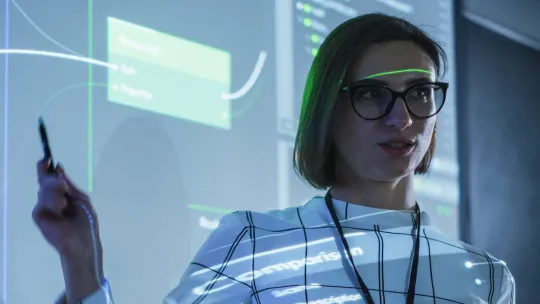
OBS Report: Development of critical thinking in higher education
Only 15% of university students have a high level of critical thinking

- AI broadens educational opportunities, but it is also leading to a homogenisation of thinking among university students.
- Despite efforts in recent years, the development of critical thinking remains uneven across disciplines, types of universities and regions. Strengthening it requires political and cultural commitment.
- A report by OBS considers it necessary for universities to precisely define which dimensions they want to reinforce, train teachers to value dissent, include projects with social impact as well as systems to evaluate critical thinking, apply incentive policies, and give teachers time for pedagogical innovation.
November 2025. The OBServatory, the OBS Business School Research Centre, institution belonging to the Planeta Formación y Universidades Higher Education Network, publishes the report Development of Critical Thinking in Higher Education, directed by professor and Doctor of Education Mireia Vendrell. It analyses the growing homogenisation of thought among Spanish university students and the importance of developing a critical eye to avoid misinformation and domestication.
According to the 2025 report "Does Higher Education Teach Students to Think Critically?", based on the assessment of more than 120,000 students, around 21% of university students are at the lowest level of critical thinking and only 15% reach the highest levels. Critical thinking is not something that flourishes by inertia. It requires explicit as well as practical teaching and contexts that value doubt, dialogue and complexity.
AI has become a new factor in learning that expands educational opportunities, but it can also generate dependencies, biases and homogenisation in thinking if it is not used with critical mediation. Universities that promote critical thinking achieve sustained progress, but those that reduce it to a rhetorical ideal or a cross-cutting statement with no real application make little progress. This gap between discourse and practice is not accidental: it reflects the structural tension between education conceived as a public good and education subject to the logic of performance, standardisation and productivity. Strengthening critical thinking therefore implies a political and cultural commitment to an idea of the university that not only transmits knowledge, but also subjects it to scrutiny and puts it at the service of social transformation.
What is critical thinking?
Critical thinking is associated with greater self-regulation and psychological well-being, promotes democratic participation, and acts as a barrier against misinformation and bias. But thinking critically requires not only knowing how to do it, but also wanting to do it. It is not an automatic process, but a deliberate practice that combines skill, attitude, and knowledge. Spanish universities are aware of its importance and in recent years it has gained prominence on their agendas, but ‘despite the efforts made, the progress achieved remains limited in relation to the relevance that the institutions themselves and international organisations attribute to this competence,’ says Professor Mireia Vendrell.
Current strategies are not generating a sustained or widespread impact. The development of critical thinking remains uneven across disciplines, types of universities and regions, highlighting the need to strengthen teacher training and consolidate coherent and sustainable assessment mechanisms.
AI and critical thinking
Digital transformation has added a decisive layer of complexity to the development of critical thinking because, although it has expanded access to information and diversified learning opportunities, it has also increased the risk of cognitive homogenisation, led to a loss of human interaction and deepened inequalities. Technologies are designed to reproduce existing asymmetries and favour those who already have an advantage. They displace spaces for collective reflection, while teachers and students have to adapt to systems that are often configured for commercial gain rather than learning.
Large-scale language models such as GPT-4 or DeepSeek R1, as well as recommendation algorithms, have transformed access to and production of academic knowledge. These systems are already used by a large proportion of university students and, despite being called “intelligent”, are based purely on statistics. This makes them useful for mechanical tasks, but students perceive depth where there is only correlation. These languages not only replace reasoning processes, but also reconfigure the very way of thinking, replacing intellectual autonomy with automated efficiency. They are designed to reinforce the prior preferences of those who use them and limit contact with dissenting perspectives, which are vital for generating debate. Consequently, if not used from a critical perspective, this technology can confine students to confirmation loops and prevent the cognitive effort required to contrast, argue and construct their own meaning.
How can critical thinking be encouraged?
The OBS report encourages universities to define precisely which dimensions they want to reinforce: the ability to analyse evidence, question assumptions, recognise one's own limitations, or make informed decisions. It also calls for training teachers in this field, because teaching critical thinking requires a teaching culture that values uncertainty, dissent, and the revision of ideas. It considers it necessary to implement projects with social impact and argumentative debates to encourage analysis, deliberation, and transformative action. It also proposes incorporating systems to evaluate critical thinking. Above all, it recommends not fighting against the implementation of AI but rather turning it into an ally, for example, by asking students to analyse and compare responses generated with this technology.
Finally, the report considers it vital for universities to implement incentive policies and give teachers time for pedagogical innovation and the evaluation of the social impact of teaching. ‘There is an urgent need to consolidate a research and action agenda that addresses critical thinking and criticality as core elements of the university project,’ it concludes.



